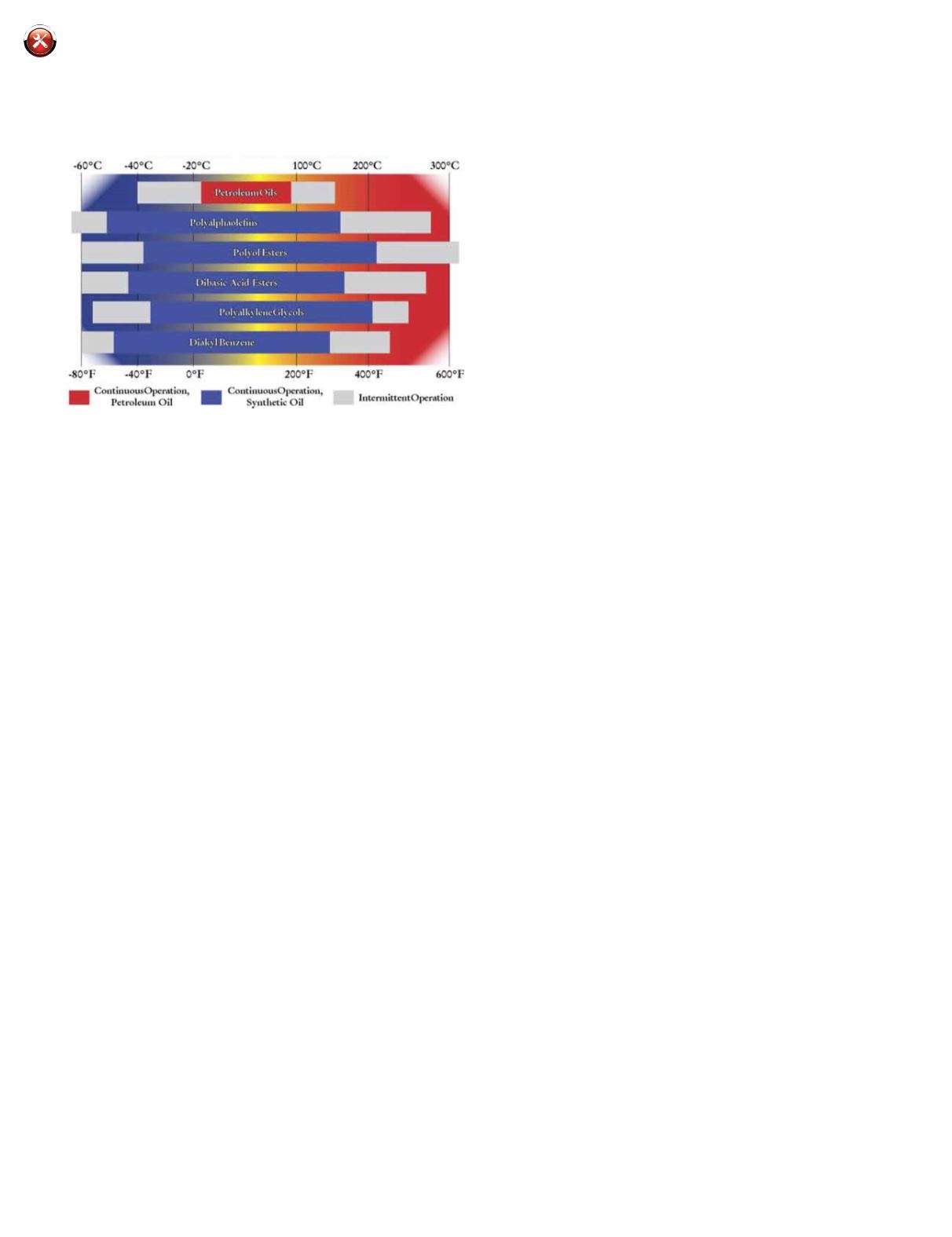
16
MARINE TECHNICIAN TODAY
|
WINTER 2014
VOLATILITY
How easily does the oil vaporize or boil off?When oils are hot, vaporization
can result in significant oil consumption and thickening of the oil. Not only
is this a problem for oil consumption, but the oil vapor is sucked into
the engine via the Positive Crankcase Ventilation system, contributing to
significant hydrocarbons in the exhaust (PCV systems have been used
in gasoline engines and are now starting to be used in diesel engines).
In petroleum oils, the molecular structure is non-uniform, consisting of
various size compounds. Imagine countless footballs, baseballs, hockey
sticks and tennis rackets all mixed together, pushing against each other.
When the oil gets hot, some of the lightweight items are liberated and fly
away while the larger, heavier items remain. As this process continues,
only the larger items remain, resulting in much thicker oil. In contrast, the
molecular structure of synthetics is like a bunch of identical golf balls, all
the same size and tightly packed together, resisting vaporization; as a result,
they stay in grade for much longer periods and reduce oil consumption.
Volatility Advantage:
Strong for Synthetics
SEALS
How does the oil affect the seals? Will it cause them to shrink or to swell?
And, is the oil chemically compatible with them? Seals aremade of a variety
of compounds in order to provide rigid but flexible surfaces that promote
good sealing in order to keep liquids in and dirt out. Petroleum oils are fully
compatible with the seal materials used in modern engines and will slightly
swell the seals. While PAO synthetics tend to shrink seals, Esters tend to
swell the seals: both are chemically compatible. In synthetics where PAO
is the primary base oil, another synthetic oil, Diester for example, is used
to provide the desired seal swell and nourishment for seals. Historically,
seal compatibility issues have caused real and imaginary problems for
synthetic oils in the market place. Currently, seal issues for properly
blended synthetic oils are no longer an issue.
Seals Advantage:
Slight for Petroleum
LUBRICATION/WEAR PROTECTION
How well does the oil lubricate and, in turn, prevent wear? Lubrication
is a result of both base oil and additive combinations performing in various
lubrication regimes in order to prevent metal-to-metal contact and the wear
that results. Where fluid film is retained, the base oil will be the dominant
factor in lubrication. Where oil film is not always able to separate the
moving metal parts, additives become the dominant factor. The uniform
molecular structure of synthetics results in a superior lubricating film.
Additionally, the thermal stability of synthetic oils maintains an oil film
in much more severe conditions – at higher temperatures, for instance
– than petroleum. Additives are relatively equal in performance regardless
of the base oil – synthetic or petroleum – with which they are combined.
Instead, the anti-wear protection they provide – or fail to provide – is
more dependent on their own quality and concentration. For normal
temperatures, properly additized petroleum oils and synthetic oils will
show similar lubricating qualities. Synthetic oils have higher film strengths
and require a lower quantity of additives in order to achieve the same level
of protection. In standard anti-wear testing such as the Shell four-ball wear
test, some synthetics achieve up to four times the wear protection when
compared to petroleum oils. When higher temperatures and pressures are
used in such tests, the results significantly favor synthetic oils.
Normal Operational Conditions Advantage:
Slightly Synthetics
Severe Operational Conditions Advantage:
Very Strongly Synthetics
OIL LIFE / ENDURANCE
How long can the oil provide proper lubrication and perform all required
functions? Oil life is a function of time and severity of service and can vary
from application to application. Oil is said to be condemned, that is, not fit
for continued service, when one or more of the following conditions exist:
• Viscosity has decreased by one grade or increased
by more than one grade
• Fuel contamination is greater than three percent
• Soot level exceeds four percent
• Total dissolved solids are greater than four percent
• Total Base Number is less than two percent
• Critical additives are depleted
• Oxidation number greater than 50 (30 for petroleum)
• Nitration number greater than 50 (30 for petroleum)
As explained above, synthetic oils are less likely to thicken as the result
of vaporization or oxidation and they stay in proper viscosity grade for
significantly longer periods of service. Several of the other factors for
condemnation are the same for either synthetic or petroleum oils and are
more dependent on the quality and concentration of chemical additives
required to continue to provide service. Soot and total dissolved solids
are products of engine combustion and are proportional to fuel air
management; turbo charged engines tend to burn cleaner than naturally
aspirated engines. Filtration, especially bypass filtration, will have direct
effects on soot and dissolved particles and can be effective at increasing
oil life. Since lubricating oils are products of base oils mixed with chemical
CHART TWO: OIL TEMPERATURE LIMITS
PETROLEUM VERSUS SYNTHETIC
,
TECH TALK


